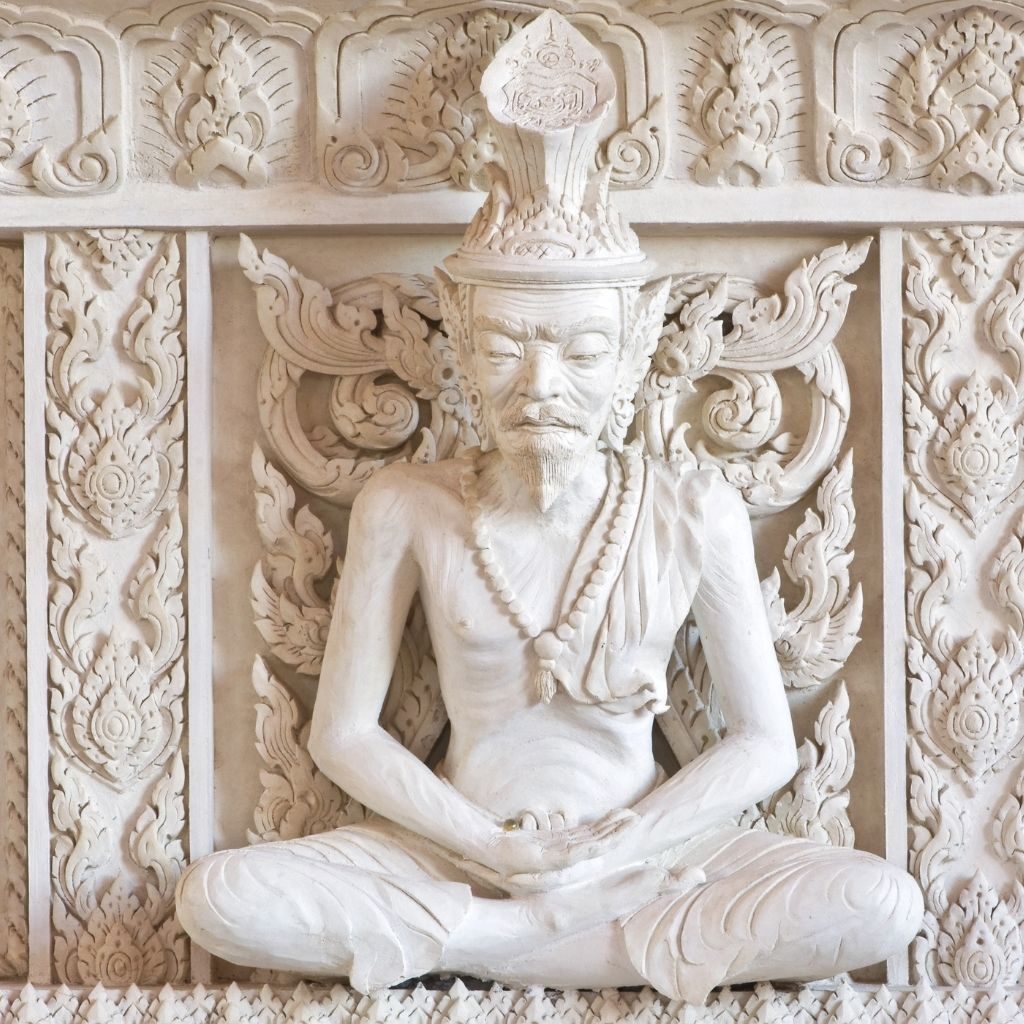Kriya Yoga vs Kundalini Yoga: 9 Essential Differences Explained!
Kriya yoga and Kundalini yoga are both systems in yoga aimed at achieving spiritual development and, ultimately, liberation.
There are, however, fundamental differences between the two, and this article is set out to demystify them and shed some light on their core principles.

The main differences include:
- They are based on different principles
- They involve different techniques of practice
- Their views on asceticism differ
- They have different origins
- Kundalini yoga includes Kriya techniques
- They follow different routes to the same goal
- There are different movements of energy present
- They have different effects on your energy systems
- Both practices have different views on God
In this article, we explain what each of these means, along with some bonus benefits, and if you are a beginner, which one to choose.
Let’s go!
1. They are based on different principles
Kriya yoga derives from Kriya, the root of which comes from the Sanskrit word ‘Kri,’ meaning to act, and is focused on specific practices that enable one to attain spiritual growth.
Kundalini yoga derives from kundalini: The divine feminine energy that lies dormant at the base of the spine and is channeled upward to the crown where divine bliss can be experienced.
2. They involve different techniques of practice
Kriya yoga consists of specific exercises that have several different levels and involve pranayama, mudra, and mantras intended to accelerate spiritual development, create a state of tranquility, and result in communion with God.
Kundalini yoga consists of practices based on asanas, pranayama, meditations, and mantra, which bring the whole body and mind into alignment to develop a higher state of awareness and spiritual strength.

3. Their views on asceticism differ
Patanjali’s Kriya yoga system involves discipline (tapaḥ), spiritual study (svadhyaya), and devotion to God (ishvarapranidhana).
Kundalini yoga follows the same three pillars of Kriya yoga; however, it does not adhere to the same levels of asceticism and renunciation as Kriya yoga.
4. They have different origins
Kriya yoga is an ancient yoga system revived by Lahiri Mahasaya, an Indian yogi, guru, and disciple of Mahavatar Babaji, a Kriya yoga master.
It gained popularity when Paramahansa Yogananda, an Indian monk, yogi, and guru, introduced Kriya yoga to the world through his book Autobiography of a Yogi.
The origin of Kundalini yoga is also ancient as it developed side by side with Hatha yoga.
In 1935, Sivananda Saraswati, a Hindu spiritual teacher, wrote a book on Kundalini yoga that got many people introduced to the practice.
5. Kundalini yoga includes Kriya techniques
Patanjali’s Kriya yoga consists of self-discipline, self-study, and devotion to God.
As we know it today, Kundalini yoga includes specific techniques from Kriya yoga, along with hatha yoga, bhakti yoga, raja yoga, and Shakti yoga.

6. They follow different routes to the same goal
Kriya yoga is referred to as The Yoga of Activity.
It exclusively postulates the activities or the practices that have been laid down as the means through which spiritual realization can be achieved.
The purification of the mind is not necessary for this route of yoga.
Kundalini yoga is referred to as The Yoga of Awareness.
Kundalini yoga helps develop and connect to one’s higher consciousness, intuition, and self-knowledge through its practices.
7. There are different movements of energy present
Paramahansa Yogananda describes the movement of energy in Kriya yoga as “upward and downward, around the six spinal centers.”
The movement of energy in Kundalini yoga is only upward, from the base chakra to the crown chakra.

8. They have different effects on your energy systems
Paramahansa Yogananda describes Kriya yoga’s effects as the “method by which the human blood is decarbonized and recharged with oxygen” to “rejuvenate the brain and spinal centers.”
An advanced yogi, therefore, “transmutes his cells into pure energy.”
Kundalini yoga causes the coiled-up energy, lying at the spine’s base, to rise through the seven chakras. Once this force is awakened, it transforms into an experience of pure bliss.
9. Both practices have different views on God
The Kriya yoga that comes from Patanjali’s kriya yoga system is based on three pillars, one of them being devotion to god (ishvarapranidhana).
Kundalini yoga, on the other hand, does not talk about worshipping god. Instead, it trains the minds of its students to experience god.
We’ll now look at the benefits of both of this practices
Wanna know more? 👉 Here we discuss the differences between kundalini yoga and kundalini tantra yoga, check it out!

What are kriyas in Kundalini?
Kriyas in kundalini yoga are a set of postures, breathwork, and sounds, that help achieve the desired outcome. A kriya initiates changes in the physical, mental, and spiritual body. It creates effects like supporting the liver, stimulating the pituitary, increasing the spine’s flexibility, and making you more radiant.
Each kriya is a specific sequence of exercises that are complete in itself and is meant to produce an impact on all levels of your being, that is, on the total Self.
There are thousands of kriyas in kundalini yoga. Some kriyas include:
- Kriya for elevation
- Kriya for strengthening the aura
- And Kriya for emotional balance
Does Kriya yoga awaken kundalini?
Kriya yoga practices deal with energy and activate the three major energy pathways located in the spine, directly impacting kundalini energy situated at the base of the spine and travels upwards through the six energy centers along the spine. In this way, kriya yoga helps to awaken kundalini.
The main objective of Kriya yoga, through its mudras, mantras, breathwork, and asana, is to awaken this dormant energy that lies at the base of the spine.
When the kundalini is awakened, it gradually moves upward through the chakras, which is aided by Kriya yoga.

What are the benefits of Kriya Yoga?
Kriya yoga has multiple benefits; some of these are realized immediately, others take longer to manifest.
Here are some of the benefits of Kriya yoga:
- Helps eradicate bad habits through meditation
- It brings greater harmony and joy in personal relationships, enabling giving and receiving unconditional love.
- It helps remove stress and promotes health and vitality
- Cultivates inner peace, greater clarity, and self-realization
- Improves concentration and efficiency at work and positively impacts one’s attitude towards work
What are the benefits of Kundalini Yoga?
Kundalini yoga has numerous benefits for the body, mind, and spirit.
Here are some of them:
- Strengthens and balances the nervous system, creating a deep state of total relaxation
- Expands the aura that helps one find protection from negativity
- Cleanses subconscious thought patterns by creating greater awareness, leading to better decision making
- Develops intuition and enables one to listen to the guidance of the inner voice
- Allows one to walk the path of dharma or conscious living

Which one is better for beginners?
Beginners can practice both Kriya yoga and Kundalini yoga. Kriya yoga starts with simple techniques that are easy to practice and are repetitive. Kundalini yoga has practices that are both physical and spiritual and can be easily practiced by beginners.
However, in both Kriya yoga and Kundalini yoga, it is best to be initiated into the practice by a teacher.
You may also like: What Happens When & After Kundalini Awakens?
The takeaway
Kriya yoga and Kundalini yoga are essentially routes to the same goal – self-actualization and self-realization.
The different yoga systems came into being because different people align better with different routes – in this case, some would with the activity style of Kriya yoga, while others with the awareness style of Kundalini yoga.
Need some more perspective on Kriya yoga and Kundalini yoga? This is an exciting video, which goes further into Kundalini yoga being a part of Kriya yoga.
Read also:

